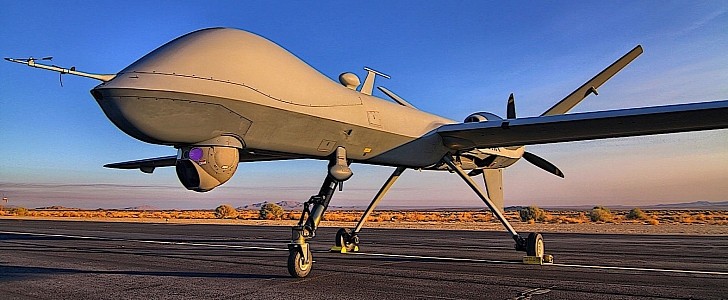The almost two-month old war in Ukraine has made one thing painfully obvious for one side, and hope-filled crystal clear for the other: the old way of waging war, with ground invading troops backed by armor of various types, is gone.
Cemented during the years of the Second World War, the tactic of sending large formations of tanks against enemy lines is rapidly proving outdated, and not on account of superior air power, because that’s something the Ukrainians do not have, but on account of drones.
One particular type of such uncrewed war machine became the sung hero of the Ukrainian army: the Turkish-made Bayraktar TB2. Capable of carrying guided bombs, anti-tank missiles, rockets, and so on, it made short work of the Russian armored vehicles, tanks in particular.
But there are other military drones out there, in Western hands, some that can make the Turkish one look like a child’s toy. The General Atomics MQ-9 Reaper is one of them, and it could soon make its way to the front lines.
Earlier this week, Forbes reported that the Ukrainians are in talks with American counterparts from General Atomics for a deal that could see Reapers fight in the European country. No government officials seem to have been involved in the talks, but the source speculates “it is unlikely that such talks between Ukraine and a U.S. defense contractor would have happened without a green light from the Biden administration.”
If a deal is approved, General Atomics reps hinted these drones could be deployed in as little as a month.
The Reaper is a turboprop-powered machine that uses a Honeywell engine. It can stay in the air for 27 hours (34 hours for the extended range variant) at a maximum altitude of 50,000 feet (15 km).
The U.S. is the main customer for this weapon, and there are about 200 of them currently in service, serving the needs of other nations as well, including UK, Italy, France and Spain.
One particular type of such uncrewed war machine became the sung hero of the Ukrainian army: the Turkish-made Bayraktar TB2. Capable of carrying guided bombs, anti-tank missiles, rockets, and so on, it made short work of the Russian armored vehicles, tanks in particular.
But there are other military drones out there, in Western hands, some that can make the Turkish one look like a child’s toy. The General Atomics MQ-9 Reaper is one of them, and it could soon make its way to the front lines.
Earlier this week, Forbes reported that the Ukrainians are in talks with American counterparts from General Atomics for a deal that could see Reapers fight in the European country. No government officials seem to have been involved in the talks, but the source speculates “it is unlikely that such talks between Ukraine and a U.S. defense contractor would have happened without a green light from the Biden administration.”
If a deal is approved, General Atomics reps hinted these drones could be deployed in as little as a month.
The Reaper is a turboprop-powered machine that uses a Honeywell engine. It can stay in the air for 27 hours (34 hours for the extended range variant) at a maximum altitude of 50,000 feet (15 km).
The U.S. is the main customer for this weapon, and there are about 200 of them currently in service, serving the needs of other nations as well, including UK, Italy, France and Spain.









